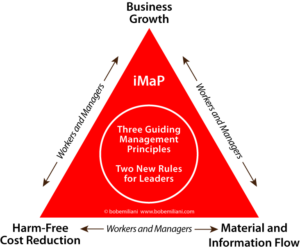
After more than three decades, we know one thing for sure: Lean management (as well as TPS) has proven itself to be inadequate as a replacement for Classical management. Why? Because Lean has failed to offer business owners and corporate executives the things that they want and need most: The economic, social, political, historical, philosophical, and business distinctions that certify power, prestige, and dozens of other important things they desire. Despite this reality, Lean continues along the same path established decades ago.
Generally, people like new things if they can easily see its benefits and if its costs (money and other forms of cost) are reasonable. Lean management has long been seen by most business owners and corporate executives as lacking benefits and unreasonably high in costs. So, Lean must be reimagined if the practice of management is to move forward.
An improved management practice must offer expanded benefits and much lower costs to business owners and corporate executives. How would one get business owners and executives to accept an improved management practice (iMaP), while also recognizing they need not sacrifice the power, prestige, and dozens of other important things they desire?
First, begin by introducing iMaP differently than the way Lean was introduced and the way in which Lean has been elaborated upon over time, both of which caused immense misunderstandings and confusion. Obviously, we must simplify. iMaP must be simple and easy to understand – and not just for business owners and executives, but for employees, suppliers, investors, customers, bankers, investment analysts, politicians, and so on.
iMaP operates on three principles: 1) “Go with the flow” regarding the wants and needs of business owners and corporate executives, 2) Material and information flow generates the lowest total costs, and 3) Those who benefit the most from higher enterprise value created by flow (executives and shareholders) must bear the cost in the form of above-average compensation for non-executive employees. The framework for iMaP is as follows:
- Daily cost reduction conducted in ways that do not harm employees or other stakeholders, to assure speed and responsiveness to changing business conditions
- Productivity improvement to assist business growth, featuring re-deployment of labor to intensify innovation and to control and stabilize employment
- Flow is the standard method for company-wide cost reduction, to control demand-driven outputs (quantity) and assure quality in every process in the company
The means for achieving flow is the designated responsibility of labor, technical staff, supervision, managers, and general managers. Together, they use their own creativity and innovations to discover and learn the many ways to make material and information flow without interruption.
Senior leaders – vice presidents, president, CEO, and boards of directors – maintain their responsibilities as usual, but must adhere to two rules:
- Do not disrupt flow or efforts to create material and information flow
- Above-average compensation for employees (paycheck, especially)

As you can see, iMaP strips out all the complexity associated with Lean management. It strips out all the uniqueness and complexity associated with Toyota’s management system as well. It strips out the problems and unhealthy nonsense that is generated by transformation, cliques, cults, and movements, etc. But, importantly, iMaP retains the core thinking and objectives behind TPS.
iMaP places just two rules on senior management. Complying with the rules will motivate non-executive employees to make the changes necessary to achieve or improve flow. They will develop their own methods and create their own language and tools in pursuit of the objective, flow.
Importantly, the need for training senior leaders is greatly reduced and centers upon comparing and contrasting continuous flow vs. blocked flow. A strong conceptual understanding of flow may be all that is required. There is no need to create “Lean leaders,” or other specialized type of executive, few of which have been created in the last 30 years anyway.
The middle manager no longer has the most difficult job. That now belongs to the general manager who must negotiate the results of material and information flow with senior managers. For example, conflicts arising from incorrect metrics, unit vs. total cost focus, etc.
iMaP respects people. In particular, all non-executive employees by giving them the freedom to do great things for themselves, the company and its stakeholders. Simultaneously, it respects and satisfies the power, prestige, and dozens of other important things that business owners and corporate executives desire.
iMaP may not be the ideal that some people want, but it is the more practical solution that many could have.
